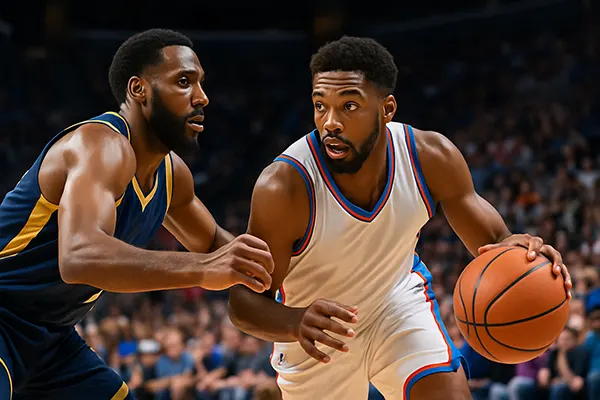Betting on individual player totals has become one of the most insightful and potentially profitable strategies in basketball wagering. Rather than relying on the unpredictable outcomes of entire games, this approach allows punters to focus on specific statistical achievements of individual players—points, rebounds, and assists. This form of betting demands a more detailed analysis but rewards those who stay informed and observant.
Understanding Player Totals and Why They Matter
Individual player totals, commonly referred to as props, involve betting on whether a basketball player will record over or under a pre-set number of points, rebounds, or assists in a single game. This is particularly useful in games where outcomes are difficult to predict but player roles remain consistent. The key lies in understanding the context surrounding each matchup—team strategy, player form, and defensive matchups.
For instance, a shooting guard averaging 25 points per game might see reduced numbers when facing a top-tier perimeter defence. On the contrary, a centre going up against a team with weak interior defence may be poised for a double-double night. Successful bettors don’t just rely on averages; they consider opposition tactics, game pace, and player motivation.
Moreover, team injuries can significantly alter a player’s usage rate. If a team’s starting point guard is out, the backup might see more ball-handling duties, increasing assist opportunities. Keeping track of these nuances is essential when making accurate predictions on player totals.
Identifying Reliable Stats and Trends
To consistently win bets on individual player totals, one must dig deep into performance trends rather than rely on surface-level stats. This includes evaluating recent form (last five games), home vs away performances, and success against similar types of opponents. For example, a player may excel at home but struggle on the road, or perform better in high-paced matchups.
Rebound and assist totals are often more consistent than points because they depend less on shooting accuracy and more on team structure and playing time. Therefore, understanding team dynamics is crucial. Who takes the most shots? Who controls the pace? Who is the primary rebounder?
Statistical websites such as Basketball-Reference, ESPN, and NBA.com offer breakdowns by game log, splits, and opponent ranks. These tools help sharpen your edge by revealing patterns that bookmakers may not fully account for when setting their lines.
Points, Rebounds, and Assists: Choosing the Right Metric
Different players excel in different categories, and knowing what to target is vital. When evaluating points, consider volume shooters with high usage rates and favourable defensive matchups. Look for players expected to play heavy minutes, especially in competitive games. Beware of games where blowouts are likely, as starters may be benched early.
Rebounds are typically best targeted with power forwards and centres. However, in modern basketball, guards like Russell Westbrook have also shown rebounding potential due to offensive systems that encourage fast transitions. Analyse team shooting percentages too—more missed shots usually result in more rebound chances.
Assists depend on ball movement and offensive flow. Primary playmakers or those with the ball in their hands most of the time are the best choices. The presence of efficient finishers in the lineup can also significantly boost assist totals, so check if teammates are in form or returning from injury.
Factoring in Defensive Matchups
Not all opponents are equal, and understanding how a team defends specific positions gives you an edge. For instance, teams like the Boston Celtics or Miami Heat are known for their tight perimeter defence, often limiting the scoring output of guards. On the other hand, teams with weak interior presence may allow multiple double-digit rebounders.
Advanced stats like Defensive Rating, Opponent Field Goal Percentage by Position, and Opponent Turnover Ratio are valuable indicators. They show how well a team guards each role on the floor and how that might affect the player you’re targeting. Tools like Synergy Sports and NBA Advanced Stats can assist in uncovering such insights.
Additionally, recent matchup history can reveal patterns. If a certain player regularly underperforms against a specific opponent or defender, that trend might be worth factoring into your betting decisions. Matchups matter more than raw averages in these contexts.

Adjusting to Game Context and Line Movement
In the hours leading up to tipoff, betting lines may shift due to injury updates, public betting trends, or insider insights. Following beat writers, injury reports, and pregame interviews helps in anticipating such changes. Bettors who react quickly to breaking news often get the best value on their picks.
Also consider situational factors—back-to-back games, travel fatigue, and playoff positioning. Players on contending teams may be rested or given limited minutes near the end of the season, while those on struggling teams might be playing for contracts or pride, influencing performance levels.
Finally, track the over/under game total. High-scoring games usually lead to inflated stats across all categories, making overs more appealing. Conversely, when two strong defensive teams face off, unders may provide greater value. Matching your player prop bets with the expected game tempo improves prediction accuracy.
Building a Consistent Strategy
Discipline is the key to long-term success in betting on player totals. Don’t chase odds or bet based on gut feelings. Stick to well-researched plays and record your results to evaluate your decision-making process over time. A well-maintained log will highlight your strengths and areas needing improvement.
Additionally, consider specialising in a few teams or player types. Understanding a handful of teams inside out will yield better results than spreading your attention too thin across the entire league. Familiarity breeds accuracy in prediction.
Ultimately, betting on player props is a data-driven craft that rewards careful planning, adaptability, and a keen understanding of basketball dynamics. When executed properly, it offers both engagement and value beyond traditional betting formats.
